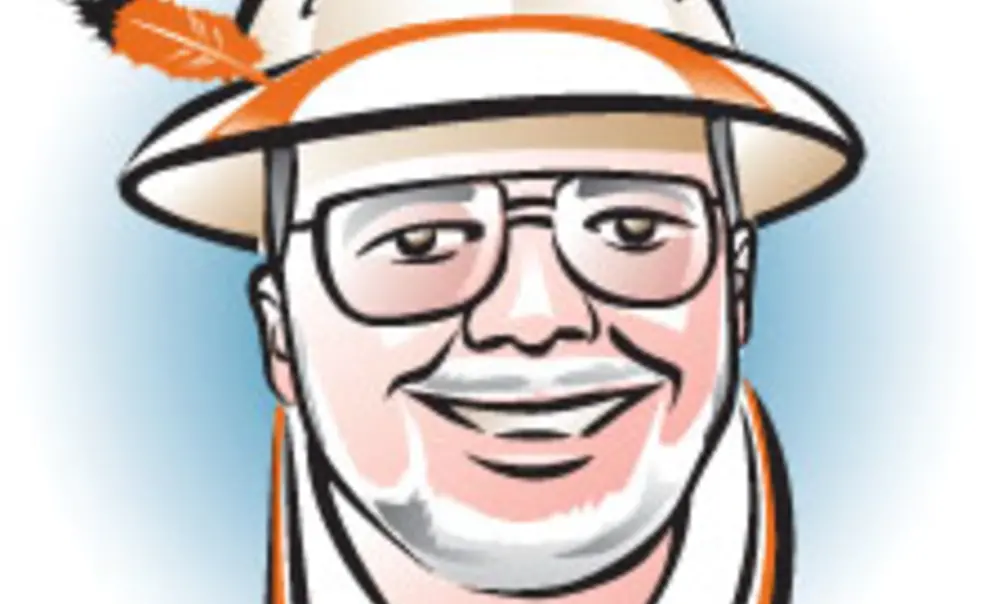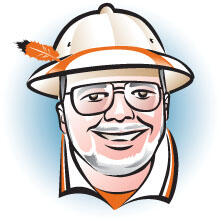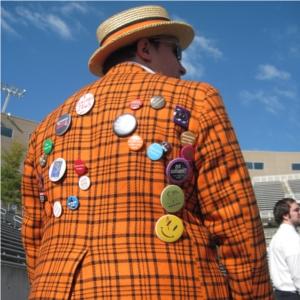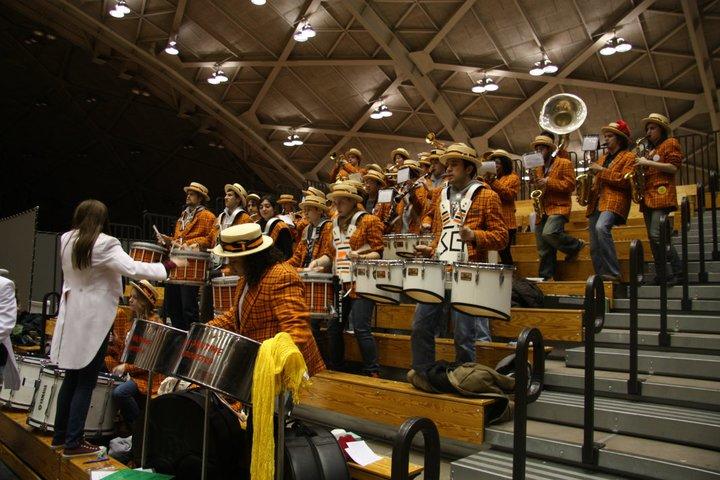With a bit of a mind flip,
you’re into the time slip
and nothing can ever be the same.
You’re spaced out on sensation
like you’re under sedation.
Let’s do the Time Warp again!
— Riff Raff and Magenta, “The Rocky Horror Show”
It is the stock in trade in the columnar vocation to evoke and invoke symbols and iconography, if only to keep our musings beneath book-length. And of course, with 266 years to work up a head of steam, Princeton veritably drips with icons, even beyond the legendary Class of ’70 pith helmet, believe it or not. Just in recent times, we’ve discussed beer jackets, the Grad College, football, the Nobel Prize; it’s hard to take keyboard in hand without tripping over two or three.
I mention this because, while this particular sojourn is triggered by a major iconographic milestone, at its roots it is also a reflection on that most ancient of humankind’s symbols: music. Like language, and sometimes in combination with it, music is so primary to the human experience that we don’t really regard it as symbolic of anything, but existential, like breathing (See Lewis, Jerry Lee; Bach, Johann Sebastian). Nonetheless, it does have particulars (such as “The Orange and the Black”) and forms (such as the University Orchestra) that represent multiple abstract ideas, and that bring to mind associated memories to both the participant and the observer that plumb the complex depths of emotion; i.e. it’s symbolic.
Which brings us to Tiger Band’s plaid blazers.
Yes, Francine, it was just 60 years ago that the bicolor apex of ’20s fashion made its appearance (30 years late, but who’s counting?) on the verdant greenswards of Ivy gridiron glory. The band had test-marketed its straw boaters with its old black jackets for a couple years before, but the addition of the (now-trademarked) orange-and-black tartan – which has nothing to do with John Witherspoon, James McCosh, or any other serious Scotsman ever born – proved to be the last word in visually expressing the singularity of the Princeton University Band and all who sail in her. Only three years after their introduction to an unsuspecting world, the jackets paraded inexorably across the cover of Sports Illustrated. And so a legendary icon was born and validated, and a scrambling (“scramble band” is an actual technical term, as is “five to 10 with time off for good behavior”) richness added to the symbolism of our melodic tradition.
Perhaps the most striking aspect of the history of music at Princeton is its longstanding avocational nature. Although proving a negative proposition is always a challenge, my strong suspicion is that this relates to the notable list of the great Scottish Presbyterian hymnists, to wit:
[ ]
To be fair, the New Lights who founded Princeton seemed a tiny bit more melodic than most of their dour brethren. President Samuel Davies even composed vocal music for the students at the Commencement of 1760. Of course, within six months the trustees had bled him and he was dead; there seems to be no connection, though. Clerics continued to oversee the College’s fortunes until 1933, and whether by coincidence or not, the music program did not come into vestigial being until 1934 (Yale’s School of Music had been founded 40 years before), and became a department only in 1946.
In the meantime, the students, at least, had gotten into the swing of things; the Nassau Lit contest to write an alma mater resulted in “Old Nassau” by Harlan Page Peck 1862 in 1859, and German professor Karl Langlotz, who had serendipitously studied under Liszt, wrote the music. The Glee Club was created by senior Andrew Fleming West (later to be the first dean of the graduate school) in 1874, then Triangle undergrads put on their first musical comedy in 1891 (with the Glee Club’s support).
At this juncture, I’m going to put the vocal portion of the story on hold until later in the year and continue with the instrumental portion of our history program, which began with various student pickup accoutrements of the Glee Club – the Instrumental Club in 1876, the Banjo Club in 1884, the Mandolin Club in 1890. (To answer the obvious question, yes, both the mandolin and banjo clubs thrived simultaneously for years; perhaps not as notable a rivalry as Whig vs. Clio, but …) Triangle put together its “jazz band” each year beginning in the 1890s, and one of its composing stalwarts, Kenneth Clark 1905, also wrote Princeton fight songs that thrive today (“Going Back to Nassau Hall,” “Princeton, Forward March,” and a slew of others). The Glee Club sometimes sang them at important football games, some Big Ten schools took it one step further and established football bands, and after World War I the stage was ripe for Tiger Band.
On Oct. 9, 1920, the group, in black sweaters and white trousers, played the well-known Princeton songs at halftime of the Maryland game, and they were off to the races, soon becoming the first ever to march onto the sacred field (avoiding disembodied teeth, ripped earflaps, and other residual combat leavings, one would imagine) during the show. By the ’50s, the band hit its full stride, with not only its spiffy blazers and national press, but an adjunct concert band that played through the year (including, frighteningly, Commencement) until 1981; it eventually morphed into the Princeton Wind Ensemble. Meanwhile, the formal University Orchestra, which had begun in fits and starts as early as 1896, gradually became today’s excellent ensemble, and as the student body grew and diversified, a formal academic program in musical performance evolved. Today, the strengthening of performing-music courses and student interest has resulted in multifarious melodious groups including Musica Alta, the fabulous Jazz Ensemble, the Sinfonia, the Composers’ Ensemble and the aforementioned Wind Ensemble, plus my symbolic favorite of the New Age, PLOrk (if you have to ask ...).
But I must admit a continuing soft spot for the great Mad, Plaid Aggregation as they pun their way through 10 halftimes a year, plus a vast menu of other sporting events that began as early as the late 1930s; the Princeton University Band subsequently has expanded to hockey, lacrosse, soccer, and the women’s iterations of each, not to mention field hockey and (reputedly) the odd squash match. And beginning with the national-power basketball teams of the Bill Bradley ’65 era, the band has joined the varsities in wide-ranging post-season adventures, by now having played at dozens of NCAA tournaments. Meanwhile, during the ’50s, halftime scripts became progressively zanier (the new jackets, mayhap?), formations became scramblier, and eventually by 1970 the halftime shows were very much as you see (and sometimes even understand) them today. And of course, Reunions without the band is like a Hoagie Haven Phat Lady without the fries. Very much like, actually.
In an era of mechanization and careerism, the Band stubbornly retains its somewhat irresponsible, but large and colorful heart. Last fall, after a late-night return trip from a football game in Virginia, a sizable representation turned up before the Sunday memorial service of their good friend and mentor Bob Rodgers ’56 to play a concert for the guests on Nassau Street; not satisfied with that, most of them stayed for the service, a distinctive plaid enhancement to the dozens of class jackets and beer jackets in the church. The group’s long-standing love affair with curmudgeonly Pete Carril also has given rise to some of its best musical moments, my own personal favorite being the introduction to basketball games in the ’90s of “The Time Warp”(see above), as perfect a marriage of the band’s spooky nature and Carril’s throwback ethos as can be found this side of Transylvania. And more than 40 years after Sports Illustrated’s cover, the band still was exhibiting a singular plaid panache: The magazine noted one of the critical aspects of Princeton’s momentous 43-41 NCAA basketball victory over UCLA in 1997:
If there really is a hoop heaven, the house band would be Princeton’s, troubadours in straw hats who played the theme from Underdog late in the Tigers’ victory.
Icon see that.















No responses yet